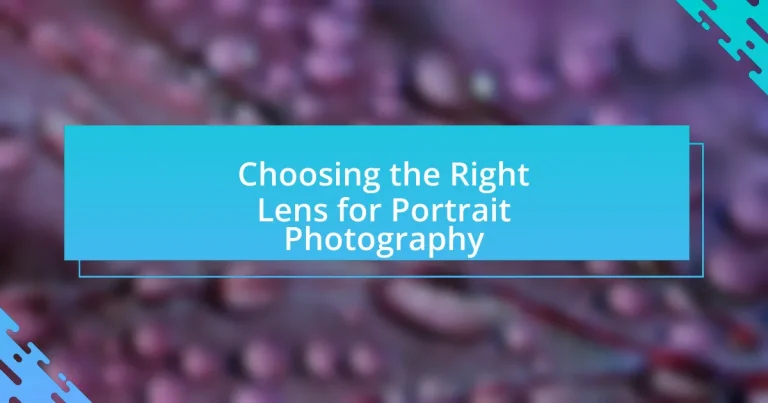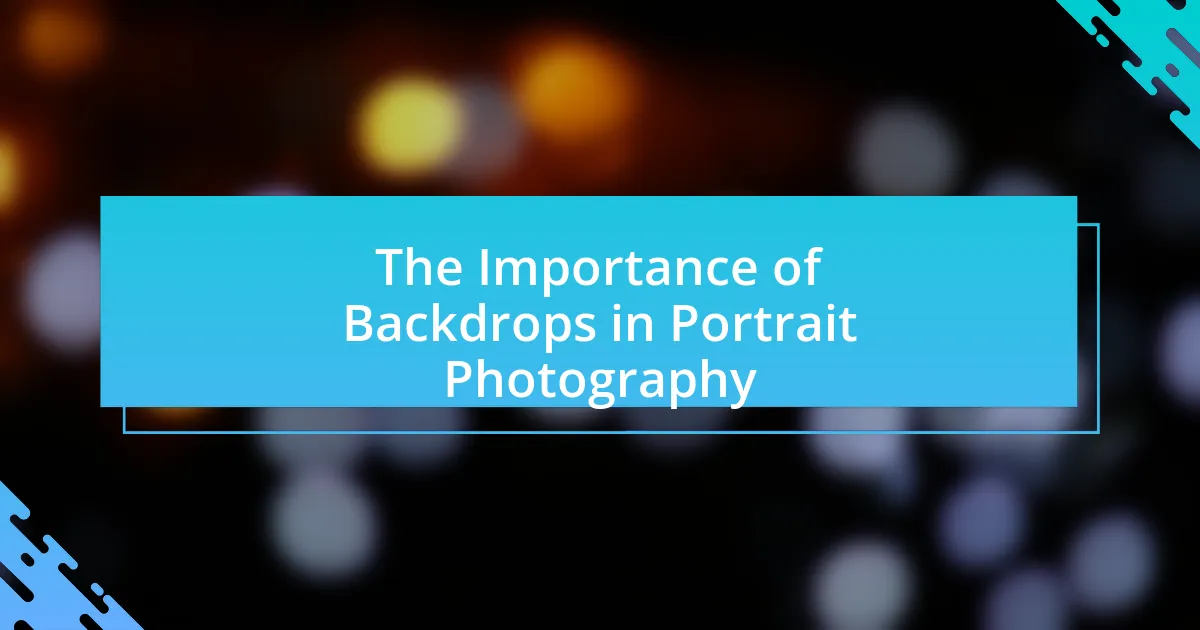Choosing the right lens for portrait photography is essential for achieving flattering and high-quality images. Key factors to consider include focal length, with 85mm to 135mm being optimal for minimizing distortion and enhancing subject isolation. The maximum aperture also plays a crucial role, as wider apertures facilitate shallow depth of field and pleasing bokeh effects. Additionally, lens quality impacts sharpness and color accuracy, while compatibility with the camera system ensures optimal performance. This article provides a comprehensive overview of these considerations, along with recommendations for specific lens models and techniques to maximize portrait photography results.
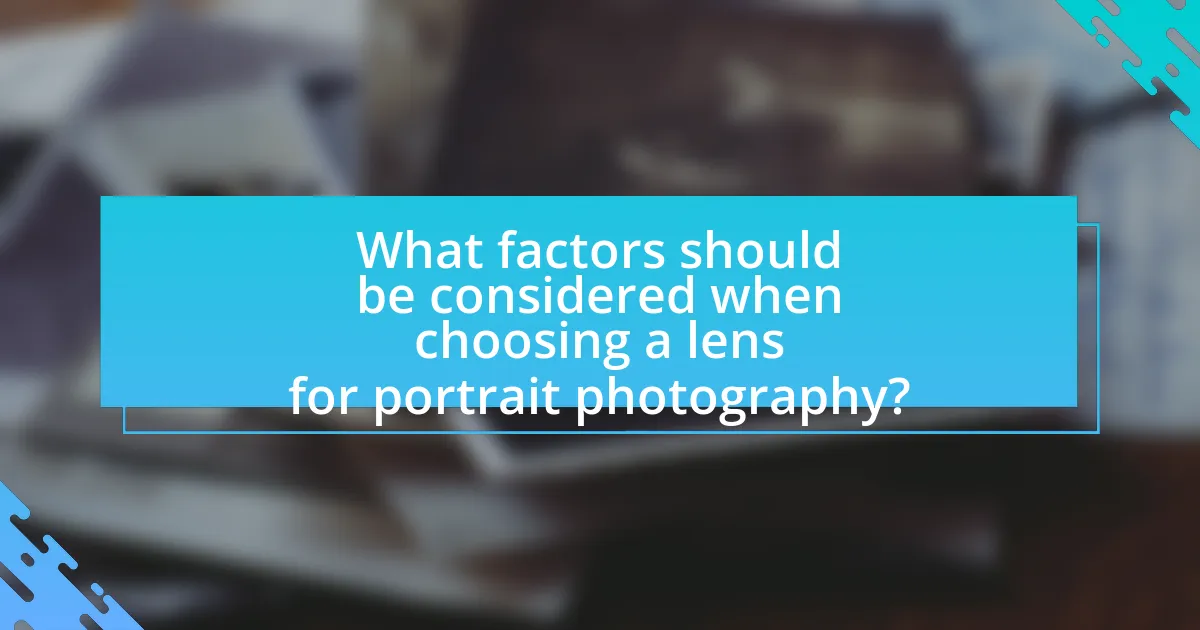
What factors should be considered when choosing a lens for portrait photography?
When choosing a lens for portrait photography, the focal length is a critical factor, as it influences the composition and perspective of the subject. Lenses with a focal length between 85mm and 135mm are often preferred for portraits because they provide flattering perspectives and allow for a comfortable working distance from the subject. Additionally, the maximum aperture of the lens is important; a wider aperture (such as f/1.8 or f/2.8) enables better subject isolation through shallow depth of field, resulting in a pleasing bokeh effect that enhances the portrait’s aesthetic. Furthermore, lens quality, including sharpness and distortion characteristics, should be considered, as high-quality lenses produce clearer images with accurate color rendition. Lastly, compatibility with the camera system is essential to ensure proper functionality and performance.
How does focal length impact portrait photography?
Focal length significantly impacts portrait photography by influencing the perspective, depth of field, and compression of the subject. Longer focal lengths, such as 85mm to 135mm, create a flattering perspective by minimizing facial distortion and providing a shallow depth of field, which helps isolate the subject from the background. This effect enhances the subject’s features and creates a pleasing bokeh. Conversely, shorter focal lengths, like 35mm, can introduce distortion, making facial features appear larger and less flattering. Studies in photography emphasize that using the appropriate focal length is crucial for achieving professional-quality portraits, as it directly affects how the subject is perceived in the image.
What are the ideal focal lengths for portrait photography?
The ideal focal lengths for portrait photography typically range from 85mm to 135mm. Focal lengths within this range allow for flattering perspectives and effective subject isolation, minimizing distortion that can occur at shorter focal lengths. For instance, an 85mm lens is widely regarded as a classic choice for portraits, as it provides a natural look while maintaining a comfortable working distance from the subject. Additionally, a 135mm lens offers even greater compression and background blur, enhancing the subject’s prominence in the frame. This range is supported by the fact that many professional portrait photographers consistently use lenses within these specifications to achieve high-quality results.
How does focal length affect perspective and distortion in portraits?
Focal length significantly affects perspective and distortion in portraits by altering the spatial relationship between the subject and the background. Shorter focal lengths, such as 24mm, can create exaggerated features and distortions, making the subject’s face appear wider and the background more pronounced. In contrast, longer focal lengths, like 85mm or 135mm, compress the background and provide a more flattering representation of facial features, minimizing distortion. This effect is supported by the principle that as focal length increases, the depth of field decreases, allowing for better subject isolation and a more aesthetically pleasing composition.
What role does aperture play in portrait photography?
Aperture plays a crucial role in portrait photography by controlling the amount of light that enters the camera and influencing the depth of field. A wider aperture (lower f-stop number) creates a shallow depth of field, which helps to isolate the subject from the background, resulting in a pleasing bokeh effect that enhances the subject’s prominence. This technique is commonly used in portrait photography to draw attention to the subject while softening distracting elements in the background. Studies show that using apertures like f/1.8 or f/2.8 can significantly improve the aesthetic quality of portraits by providing this isolation effect, making the subject stand out more effectively.
How does a wide aperture influence depth of field?
A wide aperture decreases depth of field, resulting in a more pronounced background blur. This effect occurs because a larger aperture allows more light to enter the lens, which narrows the range of distances that appear in focus. For instance, using an aperture of f/1.8 creates a shallow depth of field, isolating the subject from the background, while an aperture of f/8 increases depth of field, bringing more elements into focus. This principle is crucial in portrait photography, where a wide aperture is often preferred to emphasize the subject and create a pleasing bokeh effect.
What are the benefits of using a lens with a fast aperture?
Using a lens with a fast aperture provides several benefits, primarily allowing for greater control over depth of field and improved performance in low-light conditions. A fast aperture, typically represented by a lower f-number, enables photographers to create a shallow depth of field, which effectively isolates the subject from the background, resulting in a more aesthetically pleasing portrait. Additionally, lenses with fast apertures can gather more light, making it easier to capture sharp images in dimly lit environments without increasing ISO settings, which can introduce noise. This capability is particularly advantageous in portrait photography, where lighting conditions can vary significantly.
Why is lens quality important in portrait photography?
Lens quality is crucial in portrait photography because it directly affects image sharpness, color accuracy, and the ability to create a pleasing bokeh effect. High-quality lenses minimize optical aberrations, ensuring that subjects are rendered with clarity and detail, which is essential for capturing the nuances of skin tones and textures. Additionally, superior lenses often feature wider apertures, allowing for better low-light performance and the ability to achieve a shallow depth of field, which isolates the subject from the background. This isolation enhances the overall aesthetic of the portrait, making it more visually appealing.
What are the characteristics of high-quality portrait lenses?
High-quality portrait lenses typically feature a wide maximum aperture, excellent optical quality, and a focal length that flatters the subject. The wide maximum aperture, often f/1.2 to f/2.8, allows for shallow depth of field, creating a pleasing background blur (bokeh) that isolates the subject. Excellent optical quality is characterized by sharpness, minimal distortion, and effective control of chromatic aberration, ensuring that details are captured accurately. A focal length between 85mm and 135mm is commonly preferred for portraiture, as it provides a natural perspective and flattering compression of facial features. These characteristics collectively enhance the overall quality of portrait photography, making high-quality portrait lenses essential for achieving professional results.
How does lens construction affect image quality?
Lens construction significantly affects image quality by influencing factors such as sharpness, distortion, and aberrations. The arrangement and type of lens elements, including their shape and material, determine how light is focused and transmitted through the lens. For instance, high-quality lenses often use aspherical elements to reduce spherical aberration, resulting in sharper images across the frame. Additionally, multi-coating on lens surfaces minimizes reflections and enhances contrast, which is crucial for capturing detailed portraits. Research indicates that lenses with better construction can yield images with higher resolution and less distortion, thereby improving overall image quality in portrait photography.
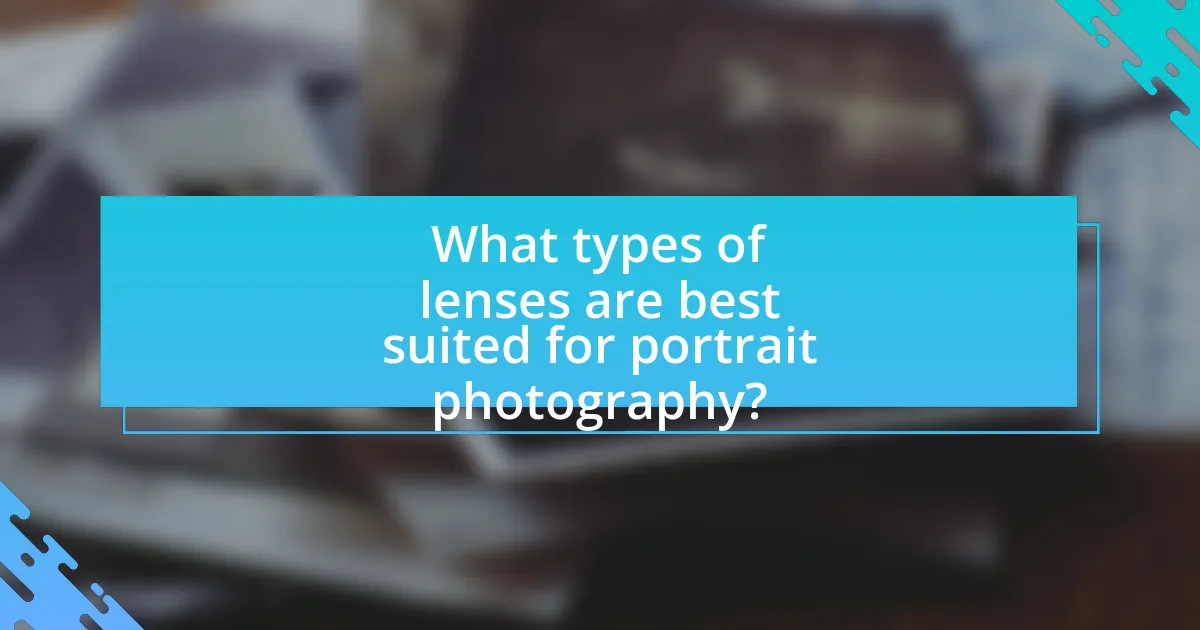
What types of lenses are best suited for portrait photography?
Prime lenses, particularly those with focal lengths between 85mm and 135mm, are best suited for portrait photography. These lenses provide a flattering perspective and allow for a shallow depth of field, which helps to isolate the subject from the background. For instance, an 85mm f/1.8 lens is widely favored for its ability to create beautiful bokeh and maintain sharpness on the subject’s features. Additionally, 50mm and 70-200mm zoom lenses are also popular choices, offering versatility and the ability to capture portraits from various distances while maintaining image quality.
What are the differences between prime and zoom lenses for portraits?
Prime lenses offer a fixed focal length, typically resulting in sharper images and better low-light performance due to wider maximum apertures, making them ideal for capturing detailed portraits. In contrast, zoom lenses provide variable focal lengths, offering versatility in composition without changing lenses, but often at the cost of image sharpness and lower maximum apertures. For instance, a 50mm f/1.8 prime lens can produce a shallower depth of field and more pronounced bokeh compared to a 24-70mm f/2.8 zoom lens, which, while versatile, may not achieve the same level of background blur.
What are the advantages of using prime lenses for portrait photography?
Prime lenses offer several advantages for portrait photography, primarily due to their superior optical quality and wider maximum apertures. The fixed focal length of prime lenses typically results in sharper images with less distortion compared to zoom lenses, making them ideal for capturing fine details in portraits. Additionally, the wider apertures, often ranging from f/1.2 to f/2.8, allow for better low-light performance and the ability to create a shallow depth of field, which beautifully isolates the subject from the background. This effect enhances the overall aesthetic of portrait images by producing a pleasing bokeh. Furthermore, prime lenses are generally lighter and more compact, facilitating easier handling and mobility during shoots.
When might a zoom lens be more beneficial for portraits?
A zoom lens might be more beneficial for portraits when flexibility in framing and composition is required. This is particularly useful in dynamic environments where the photographer needs to quickly adjust the focal length to capture different angles or distances without changing lenses. For instance, a zoom lens allows for a range of focal lengths, such as 24-70mm, which can accommodate both wide shots and close-ups, making it easier to adapt to varying subjects and settings. Additionally, zoom lenses often feature image stabilization, which can enhance sharpness in portrait photography, especially in lower light conditions.
Which specific lens models are recommended for portrait photography?
The recommended lens models for portrait photography include the Canon EF 85mm f/1.2L II USM, Nikon AF-S 85mm f/1.4G, and Sony FE 85mm f/1.4 GM. These lenses are favored for their ability to produce sharp images with beautiful bokeh, which enhances the subject’s features while softly blurring the background. The Canon EF 85mm f/1.2L II is known for its exceptional low-light performance and depth of field control, making it ideal for portraits. The Nikon AF-S 85mm f/1.4G offers a similar focal length with a fast aperture, providing excellent subject isolation. The Sony FE 85mm f/1.4 GM is praised for its high resolution and contrast, making it a top choice for Sony users. Each of these lenses has been widely reviewed and recommended by professional photographers for their effectiveness in portrait work.
What are the top prime lenses for portrait photography?
The top prime lenses for portrait photography include the Canon EF 85mm f/1.2L II, Nikon AF-S NIKKOR 85mm f/1.4G, and Sony FE 85mm f/1.4 GM. These lenses are favored for their ability to produce sharp images with beautiful bokeh, making them ideal for capturing the details and nuances of a subject’s face. The Canon EF 85mm f/1.2L II is renowned for its exceptional low-light performance and depth of field control, while the Nikon AF-S NIKKOR 85mm f/1.4G offers a balance of sharpness and contrast. The Sony FE 85mm f/1.4 GM is praised for its advanced optical design, providing outstanding clarity and color accuracy. Each of these lenses has been extensively reviewed and tested by photographers, confirming their status as top choices for portrait work.
What are the best zoom lenses for capturing portraits?
The best zoom lenses for capturing portraits include the Canon EF 24-70mm f/2.8L II USM, Nikon AF-S 24-70mm f/2.8E ED VR, and Sony FE 24-70mm f/2.8 GM. These lenses are favored for their versatility and ability to produce sharp images with beautiful bokeh, essential for portrait photography. The Canon and Nikon models feature a constant f/2.8 aperture, allowing for excellent low-light performance and depth of field control, while the Sony lens offers similar capabilities with advanced optical design. Each lens has been widely reviewed and recommended by professional photographers for their image quality and reliability in various shooting conditions.
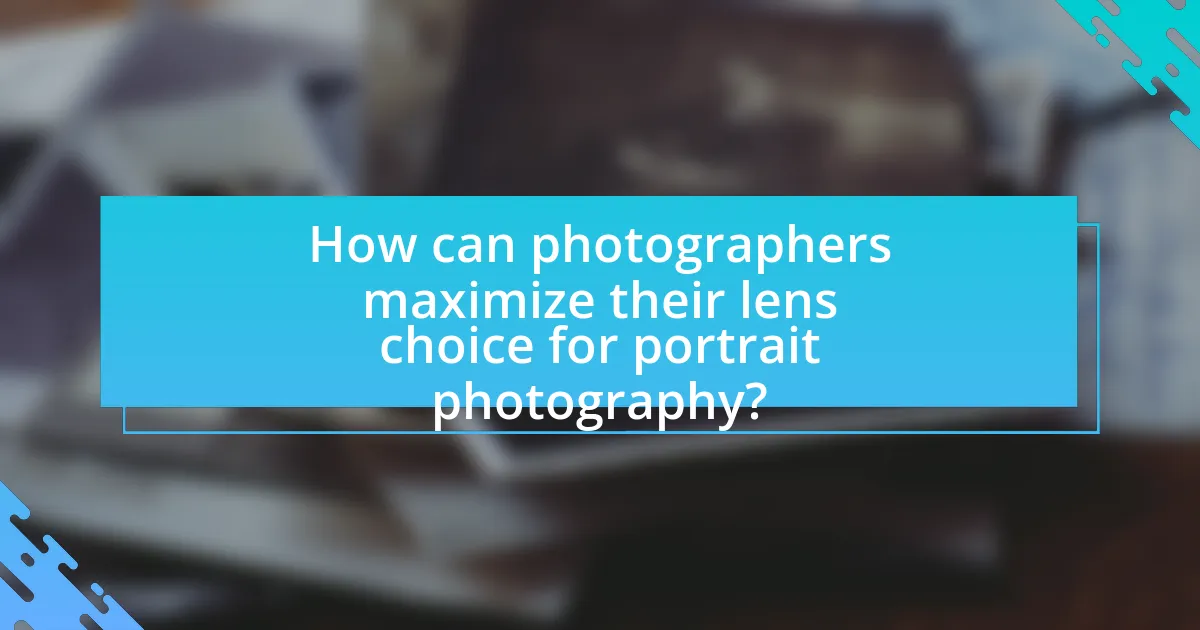
How can photographers maximize their lens choice for portrait photography?
Photographers can maximize their lens choice for portrait photography by selecting lenses with appropriate focal lengths and apertures that enhance subject isolation and background blur. Lenses in the range of 85mm to 135mm are ideal for portraits, as they provide flattering perspectives and minimize distortion. Additionally, using lenses with wide apertures, such as f/1.8 or f/2.8, allows for a shallow depth of field, which effectively separates the subject from the background, creating a more professional look. This approach is supported by the fact that many professional portrait photographers prefer these specifications to achieve high-quality results.
What techniques can enhance portrait photography with the chosen lens?
Using a prime lens with a wide aperture can significantly enhance portrait photography by creating a shallow depth of field that isolates the subject from the background. This technique allows for a pleasing bokeh effect, which emphasizes the subject and reduces distractions. Additionally, utilizing natural light or soft diffused lighting can further enhance the subject’s features and skin tones, making the portrait more visually appealing. Research indicates that portraits taken with a wide aperture (e.g., f/1.8 or f/2.8) result in a more professional look due to the soft background blur, which is often preferred in portrait photography.
How can lighting be adjusted to complement the lens used?
Lighting can be adjusted by modifying its intensity, direction, and quality to complement the lens used in portrait photography. For instance, a wide aperture lens (like f/1.8) benefits from softer, diffused lighting to reduce harsh shadows, while a lens with a smaller aperture (like f/8) can handle more direct light, enhancing detail and sharpness. Additionally, using reflectors or diffusers can help control the light’s quality, ensuring it matches the lens’s characteristics. This approach is supported by the principle that different lenses interact with light differently, affecting the overall image quality and aesthetic.
What composition tips should be considered when using different lenses?
When using different lenses for portrait photography, consider the focal length and depth of field to achieve the desired composition. A longer focal length, such as 85mm to 135mm, compresses the background and creates a pleasing bokeh effect, isolating the subject effectively. In contrast, a shorter focal length, like 35mm to 50mm, allows for more environmental context but may distort facial features if used too close. Additionally, using a wide aperture (e.g., f/1.8 or f/2.8) enhances subject separation by blurring the background, while a smaller aperture (e.g., f/8) increases depth of field, which can be useful for group portraits. These techniques are supported by the principles of optics, where focal length directly influences perspective and depth perception in photography.
What common mistakes should be avoided when selecting a lens for portraits?
When selecting a lens for portraits, common mistakes to avoid include choosing a lens with an inappropriate focal length, neglecting the importance of aperture, and overlooking lens quality. Using a lens with a focal length that is too wide can distort facial features, while a focal length that is too long may compress the subject and background unnaturally. A lens with a wide aperture is crucial for achieving a shallow depth of field, which helps to isolate the subject from the background; failing to consider this can result in less impactful images. Additionally, selecting a low-quality lens can lead to issues such as chromatic aberration and poor sharpness, which detract from the overall quality of portrait photography.
How can misunderstanding focal lengths lead to poor portrait results?
Misunderstanding focal lengths can lead to poor portrait results by causing distortion and improper framing. For instance, using a wide-angle lens (e.g., 24mm) for portraits can exaggerate facial features, making noses appear larger and faces look wider, which is generally unflattering. In contrast, a longer focal length (e.g., 85mm to 135mm) compresses facial features and provides a more pleasing perspective, enhancing the subject’s appearance. Studies in photography emphasize that focal lengths between 85mm and 135mm are optimal for portraits, as they minimize distortion and create a natural look. Therefore, selecting the wrong focal length directly impacts the quality and aesthetic of portrait photography.
What are the pitfalls of using the wrong aperture settings in portraits?
Using the wrong aperture settings in portraits can lead to undesirable outcomes such as improper depth of field, loss of detail, and unflattering focus. When the aperture is set too wide, the subject may appear out of focus if they move slightly, while a narrow aperture can result in excessive depth of field, distracting from the subject. Additionally, incorrect aperture settings can cause issues with exposure; for instance, a wide aperture may overexpose bright areas, while a narrow aperture can underexpose the subject in low light. These pitfalls can detract from the overall quality and impact of the portrait, making it crucial to select the appropriate aperture for the desired artistic effect and technical accuracy.
What are some practical tips for choosing the right lens for portrait photography?
For portrait photography, a prime lens with a focal length between 85mm and 135mm is ideal, as it provides flattering compression and a shallow depth of field. This range minimizes distortion and allows for beautiful background blur, enhancing the subject’s features. Additionally, a lens with a wide maximum aperture, such as f/1.8 or f/1.4, enables better low-light performance and creates a more pronounced bokeh effect, which is essential for isolating the subject from the background. These characteristics are supported by the fact that many professional portrait photographers prefer these specifications for achieving high-quality results.












